
Researchers at Tokyo Tech identify the quantum critical point in superconductors, solving a three-decade-old mystery and enhancing the understanding of superconductivity fluctuations. Credit: SciTechDaily.com
Thermoelectric effect reveals full picture of fluctuations in superconductivity.
Weak fluctuations in superconductivity,[1] a precursor phenomenon to superconductivity, have been successfully detected by a research group at Tokyo Institute of Technology (Tokyo Tech). This breakthrough was achieved by measuring the thermoelectric effect[2] in superconductors over a wide range of magnetic fields and over a wide range of temperatures from much higher than the superconducting transition temperature to very low temperatures near absolute zero.
This revealed the full picture of fluctuations in superconductivity with respect to temperature and magnetic field, and demonstrated that the origin of the anomalous metallic state in magnetic fields, which has been an unsolved problem in the field of two-dimensional superconductivity[3] for 30 years, is the existence of a quantum critical point[4] where quantum fluctuations are at their strongest.
Understanding Superconductors
A superconductor is a material in which electrons pair up at low temperatures, resulting in zero electrical resistance. It is used as a material for powerful electromagnets in medical MRI and other applications. They are also deemed crucial as tiny logic elements in quantum computers that operate at cryogenic temperatures, and there is a need to elucidate the properties of superconductors at cryogenic temperatures when they are microminiaturized.
Atomically thin two-dimensional superconductors are strongly affected by fluctuations and thus exhibit properties that differ significantly from those of thicker superconductors. There are two types of fluctuations: thermal (classical), which is more pronounced at high temperatures, and quantum, which is more important at very low temperatures, and the latter causes a variety of interesting phenomena.
For example, when a magnetic field is applied perpendicularly to a two-dimensional superconductor at absolute zero and increased, a transition occurs from zero resistance superconductivity to an insulator with localized electrons. This phenomenon is called the magnetic field-induced superconductor-insulator transition and is a typical example of a quantum phase transition[4] caused by quantum fluctuations.

Figure 1. (Left) In a magnetic field of moderate magnitude, magnetic flux lines penetrate in the form of defects accompanied by vortices of superconducting currents. (Center) Conceptual diagram of the “superconducting fluctuation” state, a precursor to superconductivity. Time-varying, spatially non-uniform, bubble-like superconducting regions are formed. (Right) Schematic diagram of thermoelectric effect measurement. Magnetic flux line motion and superconducting fluctuations generate a voltage perpendicular to the heat flow (temperature gradient). Credit: Koichiro Ienaga
However, it has been known since the 1990s that for samples with relatively weak localization effects, an anomalous metallic state appears in the intermediate magnetic field region where the electrical resistance is several orders of magnitude lower than the normal state. The origin of this anomalous metallic state is thought to be a liquid-like state in which magnetic flux lines (Fig. 1 left) that penetrate into the superconductor move around due to quantum fluctuations.
However, this prediction has not been substantiated because most previous experiments on two-dimensional superconductors have used electrical resistivity measurements that examine the voltage response to current, making it difficult to distinguish between voltage signals originating from the motion of magnetic flux lines and those originating from the scattering of normal-conducting electrons.
A research team led by Assistant Professor Koichiro Ienaga and Professor Satoshi Okuma of the Department of Physics, School of Science at Tokyo Tech reported in Physical Review Letters in 2020 that quantum motion of magnetic flux lines occurs in an anomalous metallic state by using the thermoelectric effect, in which voltage is generated with respect to heat flow (temperature gradient) rather than current.
However, to further clarify the origin of the anomalous metallic state, it is necessary to elucidate the mechanism by which the superconducting state is destroyed by quantum fluctuation and transitions to the normal (insulating) state. In this study, they performed measurements aimed at detecting the superconducting fluctuation state (center of Fig. 1), which is a precursor state of superconductivity and is thought to exist in the normal state.
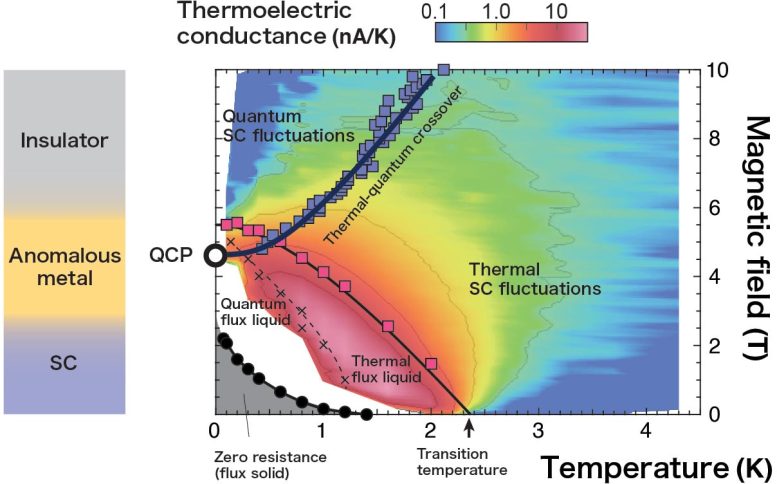
Figure 2. The full picture of fluctuations in superconductivity has been revealed over a wide magnetic field range and over a wide temperature range, from much higher than the superconducting transition temperature to very low temperature of 0.1 K. The existence of a crossover line between thermal (classical) and quantum fluctuations is demonstrated for the first time, and the quantum critical point where this line reaches absolute zero is found to exist inside the anomalous metallic region. Credit: Koichiro Ienaga
Research Achievements and Techniques
In this study, a molybdenum-germanium (MoxGe1-x) thin films with an amorphous structure,[5] known as a two-dimensional superconductor with uniform structure and disorder, was fabricated and used. It is 10 nanometers thick (one nanometer is one billionth of a meter) and promises to have the fluctuation effects characteristic of two-dimensional systems.
Since fluctuation signals cannot be detected by electrical resistivity measurements because they are buried in the signal of normal-conducting electron scattering, we performed thermoelectric effect measurements, which can detect two types of fluctuations: (1) superconducting fluctuations (fluctuations in the amplitude of superconductivity) and (2) magnetic flux line motion (fluctuations in the phase of superconductivity).
When a temperature difference is applied in the longitudinal direction of the sample,the superconducting fluctuations and the motion of the magnetic flux lines generate a voltage in the transverse direction. In contrast, normal electron motion generates voltage primarily in the longitudinal direction. Especially in samples such as amorphous materials, where electrons do not move easily, the voltage generated by electrons in the transverse direction is negligible, so the fluctuation contribution alone can be selectively detected by measuring the transverse voltage (Fig. 1, right).
The thermoelectric effect was measured in a variety of magnetic fields and in a variety of temperatures ranging from much higher than the superconducting transition temperature of 2.4 K (Kelvin) to very low temperature of 0.1 K (1/3000 of 300 K, the room temperature), which is close to absolute zero. That reveals that superconducting fluctuations survive not only in the liquid region of the magnetic flux (dark red region in Fig. 2), where superconducting phase fluctuations are more pronounced, but also over a wide temperature-magnetic field region farther outwards that is considered to be the normal-state region, where superconductivity is destroyed (the high-temperature and high-magnetic field region above the upper convex solid line in Fig. 2). Notably, the crossover line between thermal (classical) and quantum fluctuations was successfully detected for the first time (thick solid line in Fig. 2).
The value of the magnetic field when the crossover line reaches absolute zero likely corresponds to the quantum critical point where quantum fluctuations are strongest, and that point (white circle in Fig. 2) is clearly located inside the magnetic field range where an anomalous metallic state was observed in the electrical resistance. It was not possible to detect the existence of this quantum critical point from electrical resistivity measurements until now.
This result reveals that the anomalous metallic state in a magnetic field at absolute zero in two-dimensional superconductors, which has remained unresolved for 30 years, originates from the existence of the quantum critical point. In other words, the anomalous metallic state is a broadened quantum critical ground state for the superconductor-insulator transition.
Implications
The thermoelectric effect measurements obtained for amorphous conventional superconductors can be regarded as standard data for the thermoelectric effect on superconductors, since they capture purely the effect of fluctuations in superconductivity without the contribution of normal-state electrons. The thermoelectric effect is important in terms of its application to electric cooling systems, etc., and there is a need to develop materials that exhibit a large thermoelectric effect at low temperatures to extend the limit of cooling temperatures. Anomalously large thermoelectric effects have been reported at low temperatures in certain superconductors, and comparison with the present data may provide a clue to their origin.
Future Development
Of academic interest that will be developed in this study is demonstrating the theoretical prediction that in two-dimensional superconductors with stronger localization effects than the present sample, the magnetic flux lines will be in a quantum condensed state6. Moving forward, we plan to deploy experiments using the methods of this study with the aim of detecting them.
The results of this study were published online in Nature Communications on March 16th, 2024.
Terms
- Fluctuations in superconductivity: The strength of superconductivity is not uniform and fluctuates in time and space. It is normal for thermal fluctuations to occur, but near absolute zero, quantum fluctuations occur based on the quantum mechanical uncertainty principle.
- Thermoelectric effect: An effect of exchanging thermal and electrical energy. A voltage is generated when a temperature difference is applied, while a temperature difference is produced when a voltage is applied. The former is being studied for application as a power generation device and the latter as a cooling device. In this study, it is used as a method to detect fluctuations in superconductivity.
- Two-dimensional superconductivity: A very thin superconductor. When the thickness becomes thinner than the distance between the pairs of electrons responsible for superconductivity, the effect of fluctuations in superconductivity becomes stronger, and the properties of the superconductors are very different from those of thicker superconductors.
- Quantum critical point, quantum phase transition: A phase transition that occurs at absolute zero when a parameter such as a magnetic field is changed is called a quantum phase transition, and is distinguished from a phase transition caused by a temperature change. The quantum critical point is the phase transition point where a quantum phase transition
soccur and where quantum fluctuations are strongest. - Amorphous structure: A structure of material in which atoms are arranged in an irregular manner and which has no crystalline structure.
- Quantum condensed state: A state in which a large number of particles fall into the lowest energy state and behave as a singular macroscopic wave. In the superconducting state, many pairs of electrons are condensed. Liquid helium also condenses when cooled to 2.17 K, producing a superfluidity with zero viscosity.
Reference: “Broadened quantum critical ground state in a disordered superconducting thin film” by Koichiro Ienaga, Yutaka Tamoto, Masahiro Yoda, Yuki Yoshimura, Takahiro Ishigami and Satoshi Okuma, 16 March 2024, Nature Communications.
DOI: 10.1038/s41467-024-46628-7


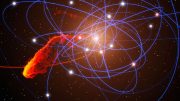
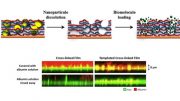

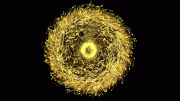
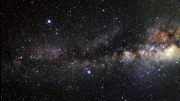
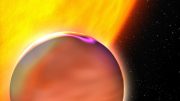

Topological vortex do not only impact the thermodynamic properties, but are also central to kinetic processes.
Physical Review Letters (PRL) is the most evil publication in the history of science. It openly fools the public without feeling ashamed.
The universe does not do algebra, formula or fraction. The universe is geometrythe,and is the superposition, deflection, and twisting of geometric shapes.
Today, we have already entered the era of the internet. With the help of artificial intelligence and big data, discussions on scientific knowledge have become open and transparent. However, a group of editors of so-called academic journals (such as Physical Review Letters, Nature, Science, etc.) are self-righteous and mystifying themselves. They only care about their own so-called sufficiently high priority rating, general significance, discipline, novelty, etc., and do not care about what science and pseudoscience are.
Science and pseudoscience are not determined by a publication, an organization or a person, nor by you or me, but by mathematics the final say. Physical models must be based on mathematics or mathematical models in order to be scientific, convincing, and in accordance with natural laws.
The origin of geometry lies in the concerns of everyday life. The branch of geometry (mathematics) known as topology has become a cornerstone of modern physics. Topological vortex and antivortex are two bidirectional coupled continuous chaotic systems. They exhibit parity conservation, charge conjugation, and time reversal symmetry. The synchronization effect is extremely important in their interactions. The synchronization effect of the superposition, deflection, and twisting of multiple or countless topological vortices will make spacetime motion more complex. To understand this complex world, physics should respect the authenticity of topological vortex in low dimensional spacetime, rather than simply relying on a few formulas, numbers, or imagined particles.
Spin is a natural property of topological vortices. Spin is synchronized with energy, spin is synchronized with gravitation, spin is synchronized with time, spin is synchronized with evolution. The perpetually swirling topological vortices defy traditional physics’ expectations. One physical properties of topological vortices is them to spontaneously begin to change periodically in time, even though the system does not experience corresponding periodic interference. Therefore, in the interaction of topological vortices, time is both absolute and relative,and physics often requires treating space and time at the same level.
Low-dimensional spacetime matter is the foundation of high-dimensional spacetime matter. Low-dimensional spacetime matter (such as topological vortex) can form new material structures and derive more complex physical properties via interactions and self-organization. It is extremely wrong and irresponsible to imagine low dimensional spacetime matter using high-dimensional spacetime matter,such as a cat in quantum mechanics.
Science must follow mathematical rules. For example, the Standard Model (SM) is considered to be one of the most significant achievements of physics in the 20th century. However, the magnetic moment of μ particle is larger than expected, revealed by a g-2 experiment at Fermilab, suggests that the established theory (such as SM) of fundamental particles is incomplete. Furthermore, the SM omitting gravitation, it not involved the time problem and when the particle movement starts. Mathematics is the foundation of science. Physics must respect the scientific nature of mathematics and mathematical models. The SM must be based on mathematical models in order to be scientific, convincing, and in line with natural laws.
I hope researchers are not fooled by the pseudoscientific theories of the Physical Review Letters (PRL), and hope more people dare to stand up and fight against rampant pseudoscience.
The so-called academic journals (such as Physical Review Letters, Nature, Science, etc.) firmly believe that two high-dimensional spacetime objects (such as two sets of cobalt-60) rotating in opposite directions can be transformed into two objects that mirror each other, is a typical case of pseudoscience rampant.
If researchers are really interested in Science and Physics, you can browse https://zhuanlan.zhihu.com/p/643404671 and https://zhuanlan.zhihu.com/p/595280873.
I am well aware that my relentless repetition can make some people unhappy, but in the fight against rampant pseudoscience, that’s all I can do.
The hidden nature of a superconductor is vapourware.